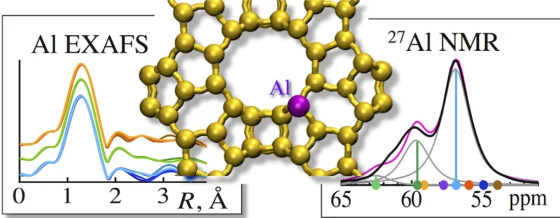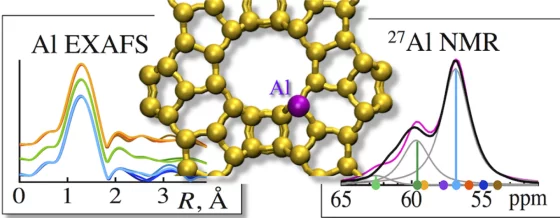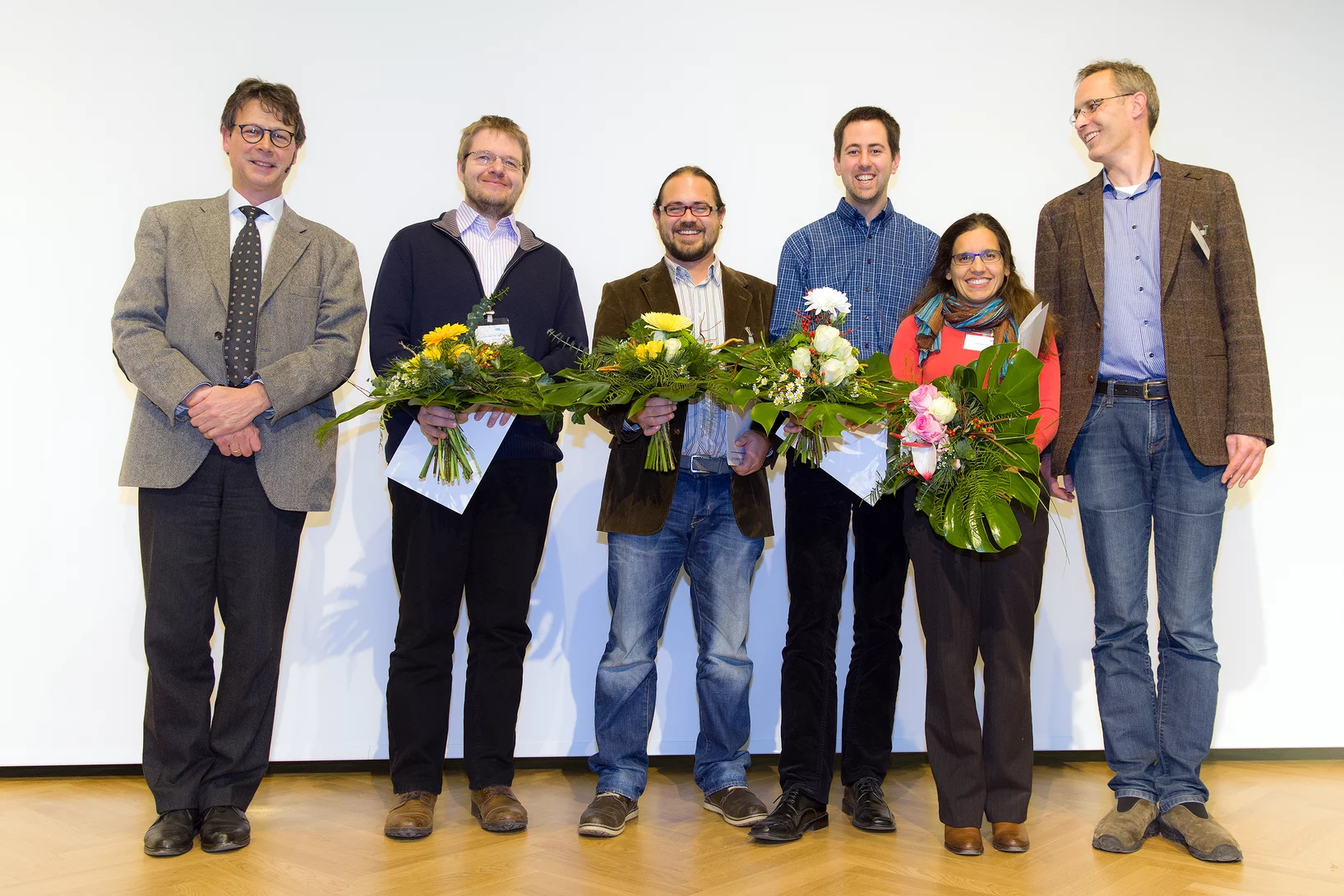Am Paul Scherrer Institut suchen Forschende nach Antworten auf die fundamentale Frage nach den Grundstrukturen der Materie und den fundamentalen Funktionsprinzipien in der Natur. Sie untersuchen Aufbau und Eigenschaften der Elementarteilchen – der kleinsten Bausteine der Materie – oder gehen der Frage nach, wie biologische Moleküle aufgebaut sind und wie sie ihre Funktion erfüllen. Das so gewonnene Wissen öffnet neue Lösungsansätze in Wissenschaft, Medizin oder Technologie.
Mehr dazu unter Überblick Grundlagen der Natur
Neuer Laser für Computerchips
Germanium-Zinn-Halbleiterlaser lässt sich direkt auf Siliziumchips aufbringenWinzige Laser, die in Computerchips aus Silizium eingebaut werden, sollen in Zukunft die Kommunikation innerhalb der Chips und zwischen verschiedenen Bauteilen eines Computers beschleunigen. Lange suchten Experten nach einem dafür geeigneten Lasermaterial, das sich mit dem Fertigungsprozess von Siliziumchips vereinbaren lässt. Wissenschaftler des Forschungszentrums Jülich und des Paul Scherrer Instituts PSI haben hier nun einen wichtigen Fortschritt erzielt.
Quantitatively Probing the Al Distribution in Zeolites
The degree of substitution of Si4+ by Al3+ in the oxygen-terminated tetrahedra (Al T-sites) of zeolites determines the concentration of ion-exchange and Brønsted acid sites. Because the location of the tetrahedra and the associated subtle variations in bond angles influence the acid strength, quantitative information about Al T-sites in the framework is critical to rationalize catalytic properties and to design new catalysts.
Quantitatively Probing the Al Distribution in Zeolites
The degree of substitution of Si4+ by Al3+ in the oxygen-terminated tetrahedra (Al T-sites) of zeolites determines the concentration of ion-exchange and Brønsted acid sites. Because the location of the tetrahedra and the associated subtle variations in bond angles influence the acid strength, quantitative information about Al T-sites in the framework is critical to rationalize catalytic properties and to design new catalysts.
Terahertz wavefront control for extremely bright THz bullet
The brightness of a light source defines its applicability to nonlinear phenomena in science. The SwissFEL laser group has now overcome one of the two principal technological hurdles to produce bright pulses in the Terahertz range (0.1-5 THz).
Competing superconducting and magnetic order parameters and field-induced magnetism in electron-doped Ba(Fe1-xCox)2As2
We have studied the magnetic and superconducting properties of Ba(Fe0.95Co0.05)2As2 as a function of temperature and external magnetic field using neutron scattering and muon spin rotation. Below the superconducting transition temperature the magnetic and superconducting order parameters coexist and compete. A magnetic field can significantly enhance the magnetic scattering in the superconducting state, roughly doubling the Bragg intensity at 13.5T.
Batman zeigt den Weg zu kompakter Datenspeicherung
Forschenden am Paul Scherrer Institut PSI ist es gelungen, winzige magnetische Strukturen mit Laserlicht umzuschalten und die Veränderung zeitlich zu verfolgen. Dabei blinkte kurz ein nanometergrosser Bereich auf, der skurrilerweise an das Fledermaus-Symbol von Batman erinnert. Die Forschungsergebnisse könnten die Datenspeicherung auf Festplatten kompakter, schneller und effizienter machen.
Nanoscale sub-100 picosecond all-optical magnetization switching in GdFeCo microstructure
Ultrafast magnetization reversal driven by femtosecond laser pulses has been shown to be a promising way to write information. Seeking to improve the recording density has raised intriguing fundamental questions about the feasibility of combining ultrafast temporal resolution with sub-wavelength spatial resolution for magnetic recording. Here we report on the experimental demonstration of nanoscale sub-100 ps all-optical magnetization switching, providing a path to sub-wavelength magnetic recording.
Geothermie als Option behalten
Eine vom Paul Scherrer Institut PSI koordinierte Studie des Zentrums für Technologiefolgenabschätzung TA-Swiss empfiehlt, die Tiefengeothermie in der Schweiz weiter voranzutreiben. Die Energieressourcen im Untergrund sind sehr gross, umweltfreundlich zu gewinnen und jederzeit verfügbar, begründen die Studienautoren ihren Befund. Das Erdbebenrisiko und die noch zu hohen Kosten bleiben Herausforderungen, die die Gesellschaft gegen den Nutzen der Geothermie abwägen muss.
Control of Tc in La0.7Sr0.3MnO3 via piezostrain
X-ray magnetic circular dichroism measurements evidence a 10K shift of the magnetic Curie temperature for La0.7Sr0.3MnO3 deposited on the piezoelectric substrate [Pb(Mg1/3Nb2/3)O3]0.68−[PbTiO3]0.32 (011) for two different remanent piezostrain states.
Anisotropic Local Modification of Crystal Field Levels in Pr-Based Pyrochlores: A Muon-Induced Effect Modeled Using Density Functional Theory
Although muon spin relaxation is commonly used to probe local magnetic order, spin freezing, and spin dynamics, we identify an experimental situation in which the measured response is dominated by an effect resulting from the muon-induced local distortion rather than the intrinsic behavior of the host compound.
PSI summer school 2015
The PSI summer school 2015 on Condensed Matter Research will be organized at the Lyceum Alpinum in Zuoz, Switzerland from August 15-21, 2015. International experts and PSI staff members will introduce and deepen your knowledge not only on methods but also on those phenomena, which are presently at the forefront of modern solid state physics and chemistry. The school will be followed by hands-on practical training at the PSI large user facilities SINQ, SμS and SLS. Online registration and detailed information is available from the school's webpage.
Coexistence of 3d-Ferromagnetism and Superconductivity in [(Li1-Fex)OH](Fe1-yLiy)Se
Superconducting [(Li1-xFex)OH](Fe1-yLiy)Se (x≈0.2, y≈0.08) was synthesized by hydrothermal methods and characterized by single-crystal and powder X-ray diffrac- tion. The structure contains alternating layers of anti-PbO type (Fe1-yLiy)Se and (Li1-xFex)OH. Electrical resistivity and magnetic susceptibility measurements reveal superconductivity at 43K.
Fractional excitations in the square-lattice quantum antiferromagnet
Quantum magnets have occupied the fertile ground between many-body theory and low-temperature experiments on real materials since the early days of quantum mechanics. However, our understanding of even deceptively simple systems of interacting spin-1/2 particles is far from complete. The quantum square-lattice Heisenberg antiferromagnet, for example, exhibits a striking anomaly of hitherto unknown origin in its magnetic excitation spectrum.
Schneller zum Porträt des Proteins
Alle Lebewesen, vom Bakterium bis zum Menschen, sind für die Verrichtung ihrer vitalen Funktionen auf Proteine angewiesen. Wie die Proteine ihre Aufgaben erfüllen, hängt von ihrer Struktur ab. Forschende des Paul Scherrer Instituts haben nun eine neuartige Methode entwickelt, um die Kristallstruktur von Proteinen mithilfe von Röntgenlicht schneller herauszufinden. Dies könnte in Zukunft auch die Entwicklung neuer Medikamente beschleunigen. Die Studie wird am 15. Dezember im Fachmagazin Nature Methods veröffentlicht.
Biomasse als Stütze der Energiewende
Mit 80 Teilnehmerinnen und Teilnehmern fand am 2. Dezember am Paul Scherrer Institut PSI die erste Jahreskonferenz des Kompetenzzentrums des Bundes für Bioenergie (SCCER BIOSWEET) statt. Das im Rahmen des Aktionsplans Energieforschung Schweiz gegründete Kompetenzzentrum definierte in der Tagung die Ziele, Strategien und Positionierung der Bioenergie-Forschung vor dem Hintergrund der neuen schweizerischen Energiepolitik.
A measurement of the neutron to 199Hg magnetic moment ratio
The neutron gyromagnetic ratio has been measured relative to that of the 199Hg atom with an uncertainty of 0.8 ppm. We employed an apparatus where ultracold neutrons and mercury atoms are stored in the same volume and report the result γn/γHg = 3.8424574(30).
Short-Range Correlations in the Magnetic Ground State of Na4Ir3O8
The magnetic ground state of the Jeff = 1/2 hyperkagome lattice in Na4Ir3O8 is explored via combined bulk magnetization, muon spin relaxation, and neutron scattering measurements. A short-range, frozen state comprised of quasistatic moments develops below a characteristic temperature of TF = 6K, revealing an inhomogeneous distribution of spins occupying the entirety of the sample volume. Quasistatic, short- range spin correlations persist until at least 20 mK and differ substantially from the nominally dynamic response of a quantum spin liquid. Our data demonstrate that an inhomogeneous magnetic ground state arises in Na4Ir3O8 driven either by disorder inherent to the creation of the hyperkagome lattice itself or stabilized via quantum fluctuations.
Measurement of the parameter ξ″ in polarized muon decay and implications on exotic couplings of the leptonic weak interaction
The muon decay parameter ξ″ has been determined in a measurement of the longitudinal polarization of positrons emitted from polarized and depolarized muons. The result, ξ″ = 0.981 ± 0.045stat ± 0.003syst, is consistent with the Standard Model prediction of unity, and provides an order of magnitude improvement in the relative precision of this parameter. This value sets new constraints on exotic couplings beyond the dominant V-A description of the leptonic weak interaction.
Innovation Award on Synchrotron Radiation 2014 for high-resolution 3D hard X-ray microscopy
The 2014 Innovation Award on Synchrotron Radiation was bestowed to researchers Ana Diaz, Manuel Guizar-Sicairos, Mirko Holler, and Jörg Raabe from the Paul Scherrer Institut, Switzerland, for their contributions to method and instrumentation development, which have set new standards in high-resolution 3D hard X-ray microscopy.
k=0 Magnetic Structure and Absence of Ferroelectricity in SmFeO3
SmFeO3 has attracted considerable attention very recently due to its reported multiferroic properties above room temperature. We have performed powder and single crystal neutron diffraction as well as complementary polarization dependent soft X-ray absorption spectroscopy measurements on floating-zone grown SmFeO3 single crystals in order to determine its magnetic structure. We found a k=0 G-type collinear antiferromagnetic structure that is not compatible with inverse Dzyaloshinskii-Moriya interaction driven ferroelectricity. While the structural data reveal a clear sign for magneto-elastic coupling at the Néel-temperature of ∼675 K, the dielectric measurements remain silent as far as ferroelectricity is concerned.
SwissFEL bereit für die Montage
In den vergangenen vier Jahren haben Forschende des PSI in der Injektor-Testanlage Schlüsseltechnologien für den Röntgenlaser SwissFEL entwickelt und auf Herz und Nieren geprüft. Nun ist das Forschungsprogramm beendet. Anfang 2015 startet die Installation der neuen Grossforschungsanlage.
Ist dies der richtige Zeitpunkt für ein waghalsiges Experiment?
PSI-Direktor Joël Mesot hat sich heute in der Aargauer Zeitung mit einem Gastkommentar zur Debatte um die Ecopop-Initiative geäussert. Lesen Sie hier seinen vollständigen Text.
Das Kompetenzzentrum Speicherung zieht nach einem Jahr Bilanz
Am vergangenen 4. November fand am Paul Scherrer Institut das erste Jahressymposium des Kompetenzzentrum des Bundes für Forschung zu Strom- und Wärmespeicherung (SCCER Heat and Electricity Storage) statt. Vertreter aus den beteiligten Forschungsgruppen sowie aus Industrieunternehmen mit einem Bezug zum Thema Speicherung berichteten in ihren Vorträgen über die jüngsten Fortschritte auf dem Gebiet der Wärme- und Stromspeicherung in der Schweiz. Die Tagung zeigte die Intensität der Transformationen, die von der Energiestrategie 2050 in Gang gesetzt worden sind.
Wenn auftauende Gletscher Schadstoffe wieder freisetzen
Wenn Gletscher infolge des Klimawandels vermehrt schmelzen, verändert sich nicht nur das Landschaftsbild. Auftauende Gletscher geben auch viele zuvor im Eis gespeicherte Schadstoffe industriellen Ursprungs in die Umwelt frei. Forschende des Paul Scherrer Instituts PSI, der Empa, der ETH Zürich und der Universität Bern haben im Rahmen eines Nationalfondsprojekts nun zum ersten Mal die Konzentration einer Klasse solcher Schadstoffe à der polychlorierten Biphenylen (PCB) à im Eis eines Alpengletschers genau gemessen.
A high-pressure hydrogen time projection chamber for the MuCap experiment
The MuCap experiment at the Paul Scherrer Institute performed a high-precision measurement of the rate of the basic electroweak process of nuclear muon capture by the proton, μ- + p → n + νμ. The experimental approach was based on the use of a time projection chamber (TPC) that operated in pure hydrogen gas at a pressure of 10 bar and functioned as an active muon stopping target. The TPC detected the tracks of individual muon arrivals in three dimensions, while the trajectories of outgoing decay (Michel) electrons were measured by two surrounding wire chambers and a plastic scintillation hodoscope.
Cheminées stellen bei Wintersmog die Autos in den Schatten
Holzfeuerungen sind an Wintersmog-Tagen in der Schweiz die Hauptquellen von gesundheitsschädigendem kohlenstoffhaltigem Feinstaub. Das zeigt eine gross angelegte Schweizer Studie zur Feinstaubbelastung, die über 5 Jahre durch Wissenschaftler des Paul Scherrer Instituts PSI, der Universität Bern und der ETH Zürich durchgeführt wurde.
Wettbewerbsfähig dank hohem Druck
Mit Verfahren, die die Tessiner Firma Casale entwickelt, werden verschiedenen Grundstoffe für die chemische Industrie hergestellt, aus denen man anschliessend Produkte wie Kunstdünger oder Plexiglas herstellen kann. In einer Kooperation mit dem PSI will Casale diese Herstellungsprozesse nun noch effizienter machen. Grundchemieerzeugnisse sind Exportprodukte, die weltweit in hartem Wettbewerb stehen. Kleinste Unterschiede in den Produktionskosten können matchentscheidend sein, wenn es darum geht, für welche Lizenz ein Anlagenbetreiber sich entscheidet.
Erstaunliches Verhalten in Hochtemperatursupraleitern beobachtet
Neuer Effekt möglicherweise wichtig für grundsätzliches VerständnisEin international besetztes Forschungsteam hat in Experimenten am PSI ein neues unerwartetes Verhalten in kupferbasierten Hochtemperatursupraleitern beobachtet. Die Erklärung des neuen Phänomens à einer unerwarteten Form gemeinsamer Bewegung der elektrischen Ladungen à stellt für die Forschenden eine grosse Herausforderung dar. Sollte sie gelingen, könnte das einen wichtigen Schritt zum Verständnis der Hochtemperatursupraleitung an sich darstellen.
Molecular Scale Dynamics of Large Ring Polymers
We present neutron scattering data on the structure and dynamics of melts from polyethylene oxide rings with molecular weights up to ten times the entanglement mass of the linear counterpart. The data reveal a very compact conformation displaying a structure approaching a mass fractal, as hypothesized by recent simulation work. The dynamics is characterized by a fast Rouse relaxation of subunits (loops) and a slower dynamics displaying a lattice animal-like loop displacement.
Eine Grossforschungsanlage verschwindet im Wald
Nur kurz durfte das Gebäude der neuen PSI-Grossforschungsanlage SwissFEL im Würenlinger Unterwald das Sonnenlicht geniessen. Zurzeit verschwindet es unter einem Erdwall. Die Überdeckung ist Teil einer Reihe von Massnahmen, die die Anlage bestmöglich in die Umgebung integrieren werden.






























